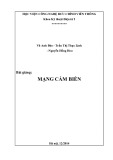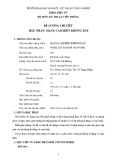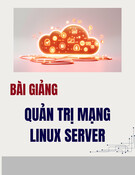
Trinh Nguyen Chien, Thuy Le Thanh, Hang Nguyen Thi Thu
Abstract— High quality of service (QoS) requirements
in multi-priority wireless sensor networks pose new
challenges to the Internet of Things (IoT). In a multi-event
wireless sensor network (MWSN), nodes generate
different types of data packets with different priority such
as urgent (high priority) or normal (low priority), with
different traffic proportion. High-priority packets require
faster transmission and higher reliability in the network. In
many recent research works, the existing media access
control (MAC) protocol for MWSN has been modified to
increase transmission efficiency and priority but has not
yet taken into account different priority traffic proportion.
Therefore, the we propose an energy-efficient MAC
algorithm that combines multiple priorities of data packets
to match the traffic proportion, called PT-MAC. PT-MAC
supports multi-events by considering four different packet
priorities and employs a new approach to adaptively
adjusting contention windows. The mathematical
estimation with different priority traffic rates is also done
in combination with the simulation in the paper, showing
that PT-MAC ensures better performance, especially
energy saving up to nearly 40 % when compared to the
predecessor protocol TMPQ-MAC.
Keywords — IoT wireless sensor network, medium
access control, energy efficiency, priority traffic
proportion.
I. INTRODUCTION
Recently, Internet of Things (IoT) and related
technologies have been rapidly developed and deployed
worldwide. IoT allows connecting not only people with
each other, but also connecting physical devices based on
low-cost sensors or smart objects, which can observe and
interact with their surroundings [1-3]. Despite the Covid-
19 pandemic, the IoT market is still growing rapidly. It is
predicted that by 2025, there will be more than 30 billion
IoT connections and on average each person has nearly 4
IoT devices [4]. Thanks to the sensing, collecting,
processing and exchanging capabilities of sensor nodes
(SNs) or smart devices, IoT has attracted considerable
attention and is deployed in various applications such as
smart wearable devices, forest fire monitoring, weather
forecast… [5- 8]. The rapid growth of IoT applications has
increased the need to support multi-priority sensor data in
multi-event wireless sensor networks (MWSNs). This has
posed a number of challenges and network performance
problems due to the computational and power limitations
of smart sensors/devices [1, 5]. Data from multiple sensor
sources is expected to be transmitted simultaneously and
instantaneously to selected receivers with different quality
of service (QoS) and reliability requirements [9]. For
example, data events such as warning (emergency)
messages need to be delivered instantaneously with high
reliability to satisfy QoS requirements while other data
packets such as information and maintenance messages
(normal) does not require immediate transmission. To deal
with such new challenges, providing flexible,
instantaneous, and reliable QoS-assured communications
becomes essential for IoTs to efficiently serve high-priority
data [1, 5, 9].
Many research works have been developed to address
the flexible requirements of QoS [10-12] and different
priority data transmission requirements, while ensuring
certain energy efficiency in WSN [12-14]. These studies
have taken into account the priority and requirement of
energy consumption separately or simultaneously and can
be classified into three main groups based on their
approach: application layer, defining priority route/queue
and MAC layer. Each approach has its own advantages and
disadvantages. For example, routing/queuing and
application-layer priority-based approaches may yield
better end-to-end performance in terms of reliability, but
these studies may encounter many difficulties in achieving
high energy efficiency [15-17]. In contrast, the MAC layer-
based approach can reduce power consumption while
maintaining communication quality [10, 18, 19]. This is
because the MAC protocol has direct control over
transceivers that consume most of the power, thus having
Trinh Nguyen Chien, Thuy Le Thanh, Hang Nguyen Thi Thu
Posts and Telecommunications Institute of Technology
PERFORMANCE ANALYSIS OF MEDIUM
ACCESS CONTROL SOLUTION BASED
ON PRIORITY TRAFFIC PROPORTION IN
MULTI-EVENT WIRELESS SENSOR
NETWORKS
Contact author: Hang Nguyen Thi Thu
Email: hangntt@ptit.edu.vn
Manuscript received: 25/7/2023, revised: 22/8/2023, accepted:
08/9/2023.
No. 03 (CS.01) 2023
JOURNAL OF SCIENCE AND TECHNOLOGY ON INFORMATION AND COMMUNICATIONS 51

PERFORMANCE ANALYSIS OF MEDIUM ACCESS CONTROL SOLUTION BASED ON PRIORITY TRAFFIC…..
a significant impact on network life. Therefore, it is
necessary to develop MAC protocols in the direction of
considering data prioritization and saving energy. These
protocols should be able to support emergency situations
where multiple sensor nodes must transmit the appropriate
data simultaneously and with the lowest possible delay to
the receiver, for the receiver to assess the severity. of the
situation [18,20]. The works of [13, 20] use multi-priority,
but [20] assigns priority based on remaining energy, rather
than data priority, and also does not guarantee the latency
of terminal packet. In addition, the study [13] considers a
limited number of data priorities and does not consider
different traffic rates. Therefore, it is necessary to develop
an energy-efficient MAC protocol that efficiently adapts
with different packet priorities to ensure QoS in the
network.
Figure 1: The operation of PT-MAC
In this study, we propose an algorithm in MAC that
supports multi-priority in multi-event WSNs and computes
traffic-based contention window, named PT-MAC. The
proposed protocol improves wireless sensor network
performance in terms of end-to-end latency, packet success
rate, and power consumption. Furthermore, PT-MAC uses
adaptive congestion windows based on the priority and
traffic ratio of different priority data to ensure end-to-end
packet delay. It exploits a combination of collision
avoidance and event priority-based servicing with four
priority levels. The preliminary idea of this paper was
presented at an international conference [21]. In which, the
initial idea of an adaptive collision avoidance scheduling
scheme using both data prioritization and traffic adaptation
and its performance is briefly introduced. To clarify the
efficiency of the developed PT-MAC, we add a
mathematical estimate for energy consumption. The
obtained simulation results demonstrate that our developed
solution outperforms its predecessor, TMPQ-MAC [22].
The rest of the paper is structured as follows. Part II
describes the proposed PT-MAC scheme. Part III is a
mathematical estimate of energy consumption. Part IV
presents the results of matching simulation with TMPQ-
MAC protocol, and the final part is the conclusion.
II. PROPOSED SOLUTION
The proposed PT-MAC protocol uses a fixed duty cycle
that describes the awake and sleep periods of the node.
However, wake and sleep times can be adjusted according
to application requirements. To deal with collisions or
hidden endpoints, RTS/CTS handshakes are used. If a
sending node needs to send a packet, it generates and
transmits an RTS message to the receiver (sink) at random
during the contention window. The RTS message includes
the required data transmission time, expressed in NAV.
After receiving the RTS successfully, other sending nodes
will go to sleep during the NAV period to avoid power
consumption for the node to stay awake and for the entire
network. Then, the receiving node selects the sender node,
generates and sends the corresponding CTS message to the
selected sending node to notify the node which has the data
to send. As soon as the appropriate CTS packet is received,
the selected sender can start transmitting its data. On
successful data reception, a corresponding ACK packet
will be sent from the receiving node to the sending node.
The S-MAC protocol mentioned in [23] also effectively
saves network power and ensures relatively low latency
due to small competition window by sending CTS as soon
No. 03 (CS.01) 2023
JOURNAL OF SCIENCE AND TECHNOLOGY ON INFORMATION AND COMMUNICATIONS 52

Trinh Nguyen Chien, Thuy Le Thanh, Hang Nguyen Thi Thu
as first RTS is received. However, S-MAC does not
incorporate packet prioritization and treats all packets
equally, resulting in all packets with the same latency and
reliability. Therefore, to meet different data transmission
requirements, a data discriminating mechanism is needed
to support low latency and high reliability for high priority
data. Therefore, in PT-MAC protocol, we inherit the idea
of prioritizing data of MPQ-MAC and TMPQ-MAC
protocols [22, 24]. We differentiate priorities based on
sending traffic. Assume that the network supports N traffic
types, in other words, up to N priority levels will be applied
and a higher priority value is assigned to the more
important data type. For example, in a network with four
types of traffic (N = 4), urgent traffic has priority of 4, most
important, important, and normal traffic has priority 3, 2
and 1 respectively. Furthermore, the collision window will
be divided into four sections according to traffic types.
Figure 1 shows the operation of the PT-MAC for two
consecutive cycles, during which the priority information
of data packets generated at the application layer is passed
down to the MAC layer.
PT-MAC uses receiver-initiated approach, after waking
up, the receiving node senses the shared media for a
guaranteed time 𝑇g and broadcasts Wake-up Beacon to all
potential sending nodes ability to announce it is ready to
receive data. A sender node can adjust its contention
window size and position according to its own data priority
and traffic rate. As illustrated in Figure 1, the contention
window is adaptive because the window will be closed as
soon as the receiving node successfully receives the RTS
(no collision). Then, the receiving node starts sending a
CTS and waits to receive data from the selected node.
Assume the network consists of 𝑀 competing senders as
shown in Figure 1. Then, sender 𝑖 can immediately send its
data while the other senders go to sleep during that data
transmission. When the data transmission is complete,
sender 𝑖 goes to sleep while the other senders 1 and 𝑀 wake
up. Then, sender 𝑀 sends its RTS in the contension
window earlier than sender 𝑖 because 𝑀 ‘s RTS has higher
priority (3 > 2). Such operations will continue until all
senders have successfully send their data. In PT-MAC,
RTS is sent from the sending node with a collision window
that varies with data priority and traffic ratio. In this
scheme, if a sending node has data to send, it first listens to
the channel to check if the channel is free and sends its RTS
frame randomly in the its resized contention window. If the
sender sense the channel and finds the channel is in busy
state, it will re-sense that channel until it finds the channel
in idle state. The starting time for sending RTS is
randomised to avoid collision of RTSs with the same
priority from other senders.
The pseudo code for RTS sending procedure in its
specified contention window is shown in Figure 2. Thus,
in PT-MAC, the RTS with the highest priority will have a
chance to appear earlier than other packets with lower
priority, so the delay of the highest priority packet will be
lower than the lower priority packet. By doing so, the PT-
MAC protocol will shorten the sending node's waiting time
to receive CTS, compared to the 𝑇𝑤 of the MPQ-MAC and
TMPQ-MAC protocols. In MPQ-MAC and TMPQ-MAC,
the contention window closes when the receiving node
receives the highest priority Tx Beacon (or RTS)
(adaptation window only applied for priority 4) or when
𝑇𝑤 expires. The window size is fixed with lower priority 1,
2 and 3. So all sending node expends energy to stay awake
and send its RTS in fixed window 𝑇𝑤 which can lead to
RTS collision and wasted energy.
1:
procedure POSITIONING WINDOWS AND SENDING RTS
IN PT-MAC
input: j, traffic rate, channel status
ouput: j-priority window location and size, RTS is
randomly sent in the window in free channel status
2:
for sender 𝑖
3:
Determine the corresponding priority 𝑗 and the
corresponding traffic rate
4:
Locate the window and assign the j-priority window
to the priority position, the highest-priority window
to be placed first, and the lower-priority window to
follow.
5:
Estimate the proportional priority window size
according to the corresponding traffic ratio.
6:
while sensing the channel do
7:
if the channel is free then
8:
At the assigned time, the sending node sends its
RTS randomly in the collision window assigned in
steps 4 and 5.
9:
else
10:
Go back to step 6
11:
endif
12:
endwhile
13:
endfor
Figure 2. Pseudo code for positioning windows and sending
RTS in PT-MAC
III. MATHEMATICAL EVALUATION
A. Assumption
In this paper, we study an IoT wireless sensor network
consisting of a receiver node at the network center (sink)
and a predefined total number of sending nodes randomly
and uniformly distributed. For computational simplicity,
the network model considers only single-hop
communication with the sending and receiving nodes being
considered within each other's wireless transmission range.
The network is targeted to apply to IoT and industrial
applications, therefore, limited to small standalone IoT
networks such as smart home, smart garden, and industrial
factory. Furthermore, the main assumptions and notation
are given as follows:
1) M is the number of contension nodes.
2) The maximum number of priorities applied is N, where
the probability of a frame having priority 𝐿𝑗 (1 ≤ 𝑗 ≤ 𝑁)
is 𝑝𝑗. In the TMPQ-MAC protocol, all priority frame types
are assumed to have equal probability, that is, 𝑝𝑗= 1 𝑁
⁄
with j=1,2,…,N. For PT-MAC, 𝑝𝑗 can be changed
adaptively according to different traffic rates.
3) With PT-MAC protocol, all sending nodes use
CSMA/CA mechanism with a contention window to send
RTS packets. The matching protocol, TMPQ-MAC, applies
No. 03 (CS.01) 2023
JOURNAL OF SCIENCE AND TECHNOLOGY ON INFORMATION AND COMMUNICATIONS 53

PERFORMANCE ANALYSIS OF MEDIUM ACCESS CONTROL SOLUTION BASED ON PRIORITY TRAFFIC…..
CSMA p-persisitet to send RTS. Therefore, the 𝑖𝑡ℎ sender
node (𝐺𝑖 where 𝑖 ∈ [1… 𝑀]) accesses the channel in the
idle state with probability 1 for PT-MAC or probability 𝑝𝑖
for TMPQ-MAC with ∑𝑝
𝑀
𝑖𝑖= 1.
4) The receiver contention window size of the PT-MAC
is denoted by CW and is the same as 𝑇𝑤 in TMPQ-MAC.
5) The PT-MAC sender contention window size is denoted
𝐶𝑊𝑗 (𝐶𝑊 =∑𝐶𝑊𝑗
𝑗
1 ) with different priorities according
to data priority and retention rate. quantity of each node.
As for the send node in TMPQ-MAC, the window size
depends on the number of contention nodes and the data
priority.
6) In the considered network, the propagation delay is
expected to be significantly smaller than the idle time and
thus, for simplicity, can be neglected [25].
7) The maximum RTS/TxBeacon retransmission value is
restricted to avoid delay exceeding the acceptance
threshold.
B. Energy consumption
The problem of computing power dissipation is a
difficult problem to calculate specifically, especially in real
situations because there are many parameters, so it can only
be estimated through the differences in the operation of the
network.
1) Transceiver energy model
The energy consumption in a wireless sensor network
has three main components: sensing, communication
(receiving, transmitting) and data processing. In which,
energy for communication is the main part [26]. The node
energy for data transmission is based on the first-order
radio model [27]. In Figure 3, 𝜀𝑒𝑙𝑒𝑐 is the energy required
to transmit or receive one bit of data, and 𝜀𝑎𝑚𝑝 is the energy
to amplify one bit of transmitter data, 𝑑 is the distance
between the transmitter and receiver.
Then, the energy consumed to send a message/frame of
length 𝑆 to a node in a distance 𝑑 can be calculated
according to the following formula [27]:
𝐸(𝑆,𝑑)= 2×𝜀𝑒𝑙𝑒𝑐 ×𝑆 +𝜀𝑎𝑚𝑝 ×𝑆 ×𝑑2 (1)
For communication networks, energy efficiency can be
defined as the inverse ratio of the average energy
consumed for the successful transmission of a data unit.
Thus, the average energy consumption for the transmission
of a data unit is less, the higher the efficiency is [24]. If a
message has to be retransmitted many times due to
dropping during transmission, the energy efficiency will be
reduced because now it can be considered that the size S in
formula (1) will be multiplied by the number of resends.
With the two protocols considered PT-MAC and
TMPQ-MAC, data is delivered from the sensor to the
destination through the SYN, RTS/CTS and ACK
mechanism, so the assumption power for communication
is not only the transmission and reception of data packets
but also for SYN, RTS/CTS frames (Figure 4). In each of
those frames/packets, there are many header bits for the
whole physical layer instead of just information for the
MAC layer or above.
Figure 4: Structure of MAC frames in PT-MAC and TMPQ-
MAC.
From the mechanism of data sending and receiving
operation in the Figure 1, it can be seen that the basic
difference in power consumption will depend on the
contention phase of sending RTS (the more RTS sent and
re-sent due to the collision, the more power consumption)
and the duration the node has to stay awake, listening,
waiting to decide whether to send the frame or not (the
longer this duration, the more power will be consumed) but
the consuming power of the data packet and
acknowledgment is the same because there is no longer a
conflict due to the application of RTS/CTS scheme.
Therefore, in the analysis of energy consumption, this
research only focuses on these two basic differences of the
two protocols.
2) One sender case
Assume there is only one sender and so there is no conflict
in sending RTS. Thus the sending probability in this case
is always 100% because th bere is no contention. Figure 5
illustrates the window position and RTS sending delay
time when there is only one send node, the start time of the
collision window is 𝑡𝑏. The packet delay is 𝑡𝑝, is calculated
as the time from the beginning of the collision
window/start of the sending cycle (excluding
synchronization issues) to the moment the data is accepted
by the receiving node (see Figure 1). Consider the duration
from the moment the sender sends the RTS to the moment
when the node has received the data and the sender receives
the ACK as 𝑡𝑟 where
𝑡𝑟= 𝑡RTS +𝑡CTS +𝑡DATA +𝑡ACK+4×𝑡SISF (1)
SYNC
RTS
/Tx-Beacon
FC
SA
FCS
FC
Priority
FCS
SA
DA
NAV
FC
DA
FCS
SA
NAV
CTS
/Rx-Beacon
DA: Destination Address FC: Frame Control
FCS: Frame Check Sequence NAV: Network Allocation Vector
SA: Source Address
Figure 3: The transceiver energy model of the
sensor node.
No. 03 (CS.01) 2023
JOURNAL OF SCIENCE AND TECHNOLOGY ON INFORMATION AND COMMUNICATIONS 54

Trinh Nguyen Chien, Thuy Le Thanh, Hang Nguyen Thi Thu
Figure 5: The arrival and reception moments of RTS in PT-
MAC and TMPQ-MAC in case of one sender.
In PT-MAC, priority windows will be ordered from
highest to lowest priority from left to right, i.e. if the RTS
with the highest priority will appear in the first random
window on the left side 𝐶𝑊4. Thus, the average packet
sending delay is
𝑡pPT
𝑗= 𝑡b+⌊𝐶𝑊 −∑𝐶𝑊𝑗+𝐶𝑊𝑗
𝑗
1/2⌋+𝑡𝑟 (2)
In TMPQ-MAC, RTS delay is
𝑡pTMPQ= {𝑡b+𝑡𝑟 𝑓𝑜𝑟 𝑝𝑟𝑖𝑜𝑟𝑖𝑡𝑦 𝑙𝑒𝑣𝑒𝑙 4
𝑡b+𝐶𝑊+𝑡𝑟 𝑓𝑜𝑟 𝑜𝑡ℎ𝑒𝑟 𝑝𝑟𝑖𝑜𝑟𝑖𝑡𝑦 𝑙𝑒𝑣𝑒𝑙 (3)
The difference in power consumption in this case is mainly
due to the average extra time the sensor waits to send the
RTS during the collision window period, which is
approximately ⌊𝐶𝑊−∑𝐶𝑊𝑗+𝐶𝑊𝑗
𝑗
1/2⌋ with PT-MAC
and [0] or [𝐶𝑊] with TMPQ-MAC. Assume there are 2
different types of traffic in the normal case (the proportion
of urgent priority traffic is small) and the critical case (the
proportion of the urgent priority traffic is large) with the
respective percentage of priority traffic (𝑝1:𝑝2:𝑝3:𝑝4=
10:20:30:40) and (𝑝1:𝑝2:𝑝3:𝑝4=25:25:25:25) that
is, the total amount remains constant at 100%; then the
average extra delay can be calculated in Table I. Thus, the
longer the waiting delay to send RTS, the higher the power
consumption will be. From the analysis, it can be seen that
the average extra delay or the average extra power
consumption of PT-MAC is lower than that of TMPQ-
MAC, corresponding to a value of 0.5CW compared to
0.90CW/ 0.75CW.
TABLE I. ANALYSIS OF ADDED TIME WHEN THERE IS A
SENDER IS A CAUSE OF DIFFERENCE IN ENERGY
CONSUMPTION
Priority
level
Protocol
p 1
p 2
p 3
p 4
Average
PT-MAC
Normal
0.050𝐶𝑊
0.200𝐶𝑊
0.450𝐶𝑊
0.800𝐶𝑊
0.500𝐶𝑊
Critical
0.125𝐶𝑊
0.375𝐶𝑊
0.625𝐶𝑊
0.875𝐶𝑊
TMPQ-MAC
Normal
0
𝐶𝑊
𝐶𝑊
𝐶𝑊
0.900𝐶𝑊
Critical
0.750𝐶𝑊
No. 03 (CS.01) 2023
JOURNAL OF SCIENCE AND TECHNOLOGY ON INFORMATION AND COMMUNICATIONS 55


![Câu hỏi ôn tập Mạng cảm biến - WSN: Tổng hợp kiến thức [Năm hiện tại]](https://cdn.tailieu.vn/images/document/thumbnail/2025/20250703/kimphuong1001/135x160/3141751517987.jpg)

















![Đề thi cuối kì Nhập môn Mạng máy tính: Tổng hợp [Năm]](https://cdn.tailieu.vn/images/document/thumbnail/2025/20251110/nminhthoi53@gmail.com/135x160/38281762757217.jpg)



![Đề thi học kì 2 môn Nhập môn Mạng máy tính [kèm đáp án]](https://cdn.tailieu.vn/images/document/thumbnail/2025/20251014/lakim0906/135x160/23811760416180.jpg)

